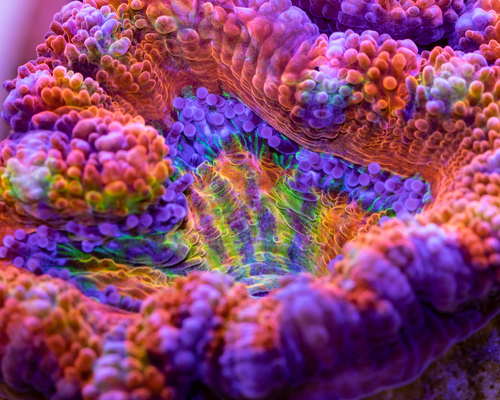Micromussa vs Acans: What’s The Difference?
Posted by Miles Harrison on 12/10/2022
There’s a lot of confusion in the reefing community about Acan corals. Known as some of the most brilliantly-colored corals available, these corals are highly sought-after by reefers looking to add a splash of color to their reef tanks.
Due to a recent species classification change, there’s a lot of confusion about what’s considered to be an Acanthastrea coral, and what’s considered to be a Micromussa coral. In this post, we’re going to clear up some of that confusion so that you can determine the similarities and differences between these two coral genera.
January's Giveaways on Light Fish
What are Acanthastrea Corals?
Acanthastrea corals are a genus of large polyp stony corals that are widespread throughout the world's oceans. Found living at depths of up to 50 meters, they live in slow-moving waters where they feed on algae and zooplankton.
Known for their wide variety of colors, they can be seen in violet, black, orange, yellow, green, red, and even rainbow. They’re great corals for beginners, as they’re hardy, slow growing, and easy to care for.

What are Micromussa Corals?
Micromussa Corals are a genus of stony corals that are in the same family (Lobophyllidae) as Acanthastrea corals. The Micromussa genus comprises many species, such as Micromussa Indiana, Micromussa Pacifica, Micromussa Amakusensis, and the most popular: Micromussa Lordhowensis, also known as the Acan Lord.
Micromussa Corals are found throughout the Indo-Pacific, living at depths of up to 45 feet below the ocean’s surface. They’re an aggressive species, and once transitioned, adapt well to reef aquariums.
Differences Between Micromussa and Acanthastrea Corals
The biggest difference between Micromussa and Acanthastrea corals is the size of their polyps. Micromussa corals will have smaller polyps than Acanthastrea corals, and polyps tend to be about an inch in diameter.
Micromussa corals also tend to be much more aggressive than their Acanthastrea counterparts. They are aggressive feeders that will occasionally attack neighboring corals. Micromussa corals will also tend to take a bit longer to adjust to a new reef tank.
Similarities Between Micromussa and Acanthastrea Corals
Micromussa and Acanthastrea corals both share similar care requirements and are highly adaptable to most tank conditions.
Both species are tolerant of a wide range of water flow and lighting and share many similarities in appearance. You can find the same wide range of colors present in both Micromussa and Acanthastrea corals.
Aim for the following water conditions if you plan on keeping Micromussa or Acanthastrea corals
Specific Gravity: 1.023-1.025
Temperature Range: 72°F-78°F
KH: 8-12 dKH
pH: 8.1-8.4
Micromussa Lordhowensis Reclassification
One of the biggest misconceptions in reef keeping revolves around Micromussa Lordhowensis, often referred to as the ‘Acan Lord’. This species gets its name from Lord Howe Island, the most southern reef in the Pacific Ocean.
Previously, this species was considered a member of the Acanthastrea genus but was reclassified under the Micromussa genus in 2016.
This re-classification has resulted in many hobbyists incorrectly identifying photos of Micromussa species as Acans, and vice-versa. Further complicated by the similarity in appearance, it can often take a trained eye to spot the difference between these two genera.

Price Comparison
Prices are species-dependent, but you can expect to pay somewhere between $10-$300 per Micromussa polyp.
Acanthastrea also has a wide range in pricing, with some polyps selling for $40, and others selling for up to $1000.
Smaller frags will be much cheaper, so you can save a good amount of money by purchasing smaller polyps and growing them to be much larger.
Conclusion
Now that we’ve cleared up some of the misconceptions about these two Coral genera, which do you think you’ll choose? We guarantee you’ll love the rainbow of colors that are produced by these amazing corals.
If you’ve had experience with owning these corals, let us know what you think of them by dropping a comment below, and be sure to check out our community forum where we discuss reef keeping and everything else related to saltwater aquariums.
January's Giveaways on Light Fish


